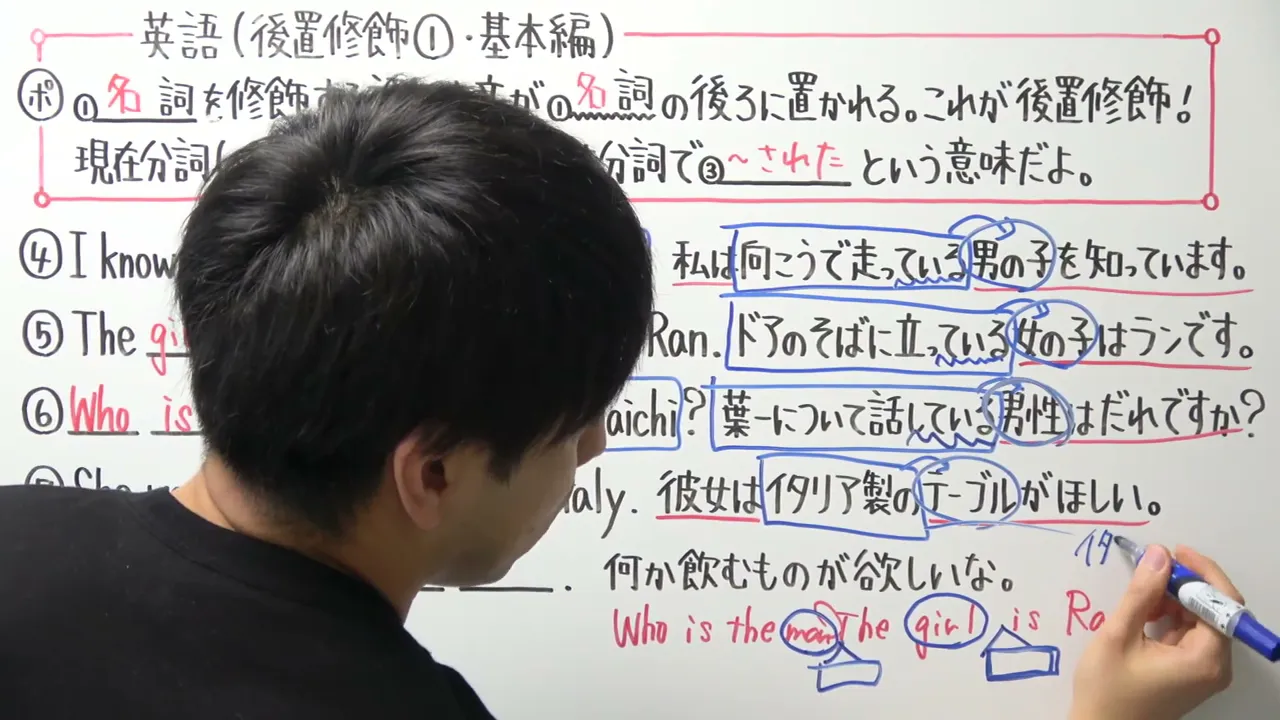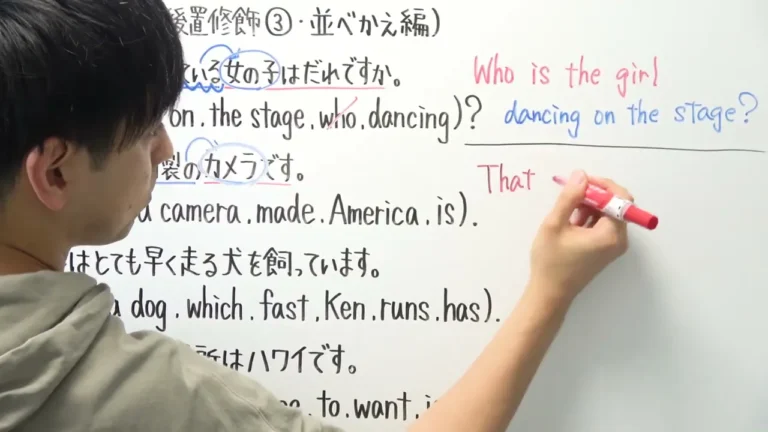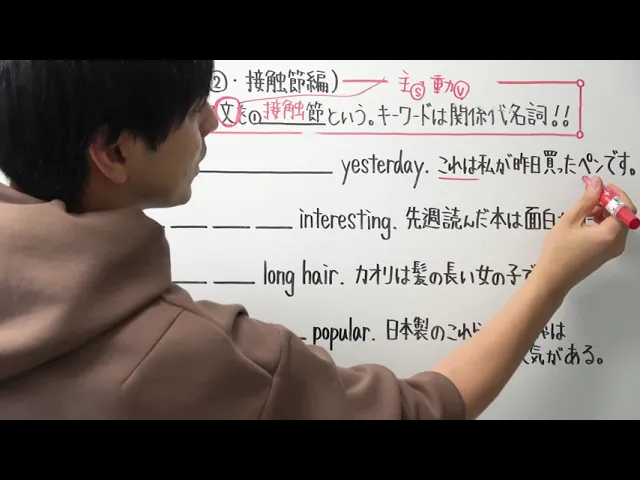後置修飾 ⓵ 基本編
ブルームの分類法の理解度チェック問題
これらの質問は、レッスンで教えられたすべてのポイントをカバーし、Bloom’s Taxonomyの各レベルで知識、理解、応用、分析、評価、創造を促すように設計されています。
Knowledge (知識)
- 後置修飾とは、どのような品詞を修飾する時に使われますか?
- What part of speech×「part of speech」は「品詞」という意味です。名詞、動詞、形容詞などが含まれます。
例文:
Nouns, verbs, and adjectives are parts of speech.
名詞、動詞、形容詞は品詞です。 is modified by×「is modified by」は「〜によって修飾される」という意味の受動態です。
文法説明:
- 受動態は「be動詞+過去分詞」で構成されます
- この文では「is modified」が受動態の形です
- 受動態は「〜される」という動作の受け手を表します
例文:
The house is painted by John.
その家はジョンによって塗られます。 a post-modifier×「post-modifier」は「後置修飾語」という意味で、名詞の後ろに置かれてその名詞を修飾する語句のことです。
文法説明:
- 「post-」は「後ろ」を意味する接頭辞
- 後置修飾語は、形容詞句、分詞句、関係詞節などがあります
- 後置修飾語は名詞の意味を具体的にします
例文:
The book on the table is mine.
テーブルの上の本は私のものです。
※「on the table」が後置修飾語です。
注意点:
- 日本語では修飾語は名詞の前にくることが一般的です
- 英語の後置修飾は日本語の感覚と異なるため注意が必要です?
- What part of speech×「part of speech」は「品詞」という意味です。名詞、動詞、形容詞などが含まれます。
- 現在分詞の形を答えなさい。
- What is the form×「form」は「形」という意味です。文法用語として使われることもあります。
例文:
What is the form of the verb in this sentence?
この文の動詞の形は何ですか? of the present participle×「present participle」は「現在分詞」という意味です。動詞のing形で、進行中の動作や状態を表します。
文法説明:
- 現在分詞は動詞の原形に「-ing」を付けて作ります
- 動詞の進行形(be動詞+現在分詞)や、名詞を修飾する形容詞的用法があります
- 現在分詞は「〜している」という意味を表します
例文:
She is reading a book.
彼女は本を読んでいます。
※「reading」は現在分詞で、進行中の動作を表します。
The running boy tripped.
走っている男の子はつまずいた。
※「running」は現在分詞で、名詞「boy」を修飾します。
よくある間違い:
- 現在分詞は「〜している」という意味を表すことに注意
- 過去分詞と混同しないように注意?
- What is the form×「form」は「形」という意味です。文法用語として使われることもあります。
- 過去分詞を使うと、どのような意味を付け加えて説明できますか?
- What kind of meaning×「meaning」は「意味」という意味です。文脈によって様々な意味を持ちます。
例文:
What is the meaning of this word?
この単語の意味は何ですか? can you add to a description×「a description」は「説明」という意味です。名詞を修飾する言葉や文を指します。
例文:
I gave a description of the thief to the police.
私は警察に泥棒の説明をしました。 by using the past participle×「past participle」は「過去分詞」という意味です。動詞の第三形で、受動的な意味や完了した動作を表します。
文法説明:
- 過去分詞は動詞の形の一つで、規則動詞は「-ed」、不規則動詞は様々な形をとります
- 受動態(be動詞+過去分詞)や完了形(have/has+過去分詞)を作ります
- 形容詞として名詞を修飾し、「〜された」という意味を表すことがあります
例文:
The book was written by him.
その本は彼によって書かれました。
※「written」は過去分詞で、受動態に使われています。
I have finished my homework.
私は宿題を終えました。
※「finished」は過去分詞で、完了形に使われています。
The broken window needs to be fixed.
壊れた窓は修理が必要です。
※「broken」は過去分詞で、名詞「window」を修飾しています。
よくある間違い:
- 受動態と完了形の使い分けに注意
- 動詞の不規則変化に注意?
- What kind of meaning×「meaning」は「意味」という意味です。文脈によって様々な意味を持ちます。
Comprehension (理解)
- 後置修飾の基本的な仕組みを、自分の言葉で説明してください。
- Explain×「Explain」は「説明する」という意味の動詞です。
例文:
Can you explain the rules?
ルールを説明できますか? the basic mechanism of×「the basic mechanism of」は「〜の基本的な仕組み」という意味です。
例文:
He explained the basic mechanism of a car engine.
彼は車のエンジンの基本的な仕組みを説明しました。 post-modification×「post-modification」は「後置修飾」という意味です。名詞を後ろから修飾する語句や節を指します。
例文:
The book on the table is mine.
テーブルの上の本は私のものです。
※「on the table」は後置修飾の例です。
文法説明:
- 形容詞句、分詞句、関係代名詞節などが後置修飾に使われます
- 後置修飾は名詞の意味を具体的にします
- 日本語の修飾は名詞の前にくることが多いですが、英語では後ろから修飾することが多いです
よくある間違い:
- 修飾語句の順序を間違えないように注意
- 後置修飾がどの名詞を修飾しているか注意する in your own words×「in your own words」は「自分の言葉で」という意味のフレーズです。
例文:
Please explain it in your own words.
それを自分の言葉で説明してください。.
- Explain×「Explain」は「説明する」という意味の動詞です。
- なぜ、現在分詞と過去分詞を使って後置修飾する時、意味が異なるのですか?
- Why is the meaning different when using the present participle×「present participle」は「現在分詞」という意味です。動詞のing形で、能動的な意味や進行中の動作を表します。
例文:
The boy running is my brother.
走っている男の子は私の弟です。 or past participle×「past participle」は「過去分詞」という意味です。動詞の第三形で、受動的な意味や完了した動作を表します。
例文:
The book written by him is interesting.
彼によって書かれた本は面白いです。 in post-modification×「post-modification」は「後置修飾」という意味です。名詞を後ろから修飾する語句や節を指します。
例文:
The car parked there is mine.
そこに駐車されている車は私のものです。?
- Why is the meaning different when using the present participle×「present participle」は「現在分詞」という意味です。動詞のing形で、能動的な意味や進行中の動作を表します。
- 「私は向こうで走っている男の子を知っています」という文を例に、修飾している部分とされている部分を特定してください。
- In the sentence×「sentence」は「文」という意味です。
例文:
This is a long sentence.
これは長い文です。, ‘I know the boy running over there’, identify×「identify」は「特定する」という意味です。
例文:
Please identify the key points.
要点を特定してください。 the part that is modifying×「the part that is modifying」は「修飾している部分」という意味です。後置修飾では、名詞を後ろから説明する部分を指します。
例文:
In 'the car parked there,' 'parked there' is the part that is modifying.
「そこに駐車された車」では、「そこに駐車された」が修飾している部分です。 and the part that is being modified×「the part that is being modified」は「修飾されている部分」という意味です。後置修飾では、修飾を受ける名詞を指します。
例文:
In 'the car parked there,' 'car' is the part that is being modified.
「そこに駐車された車」では、「車」が修飾されている部分です。.
- In the sentence×「sentence」は「文」という意味です。
Application (応用)
- 「ドアのそばに立っている女の子はランです」という文を英語で完成させてください。
- Complete the sentence×「Complete the sentence」は「文を完成させる」という意味です。
例文:
Please complete the sentence with the correct words.
正しい単語で文を完成させてください。 in English.
- Complete the sentence×「Complete the sentence」は「文を完成させる」という意味です。
- 「私が作ったケーキは美味しい」という文を、後置修飾を使って英語にしてください。
- Translate×「Translate」は「翻訳する」という意味です。
例文:
Can you translate this sentence into Japanese?
この文を日本語に翻訳できますか? the sentence using post-modification×「using post-modification」は「後置修飾を使って」という意味です。名詞を後ろから修飾する表現を用いて翻訳することを指します。
例文:
Translate the sentence using post-modification.
後置修飾を使ってその文を翻訳してください。.
- Translate×「Translate」は「翻訳する」という意味です。
- 以下の日本語の語句を英訳しなさい。
- Translate the following Japanese phrases×「the following Japanese phrases」は「以下の日本語の語句」という意味です。
例文:
Translate the following Japanese phrases into English.
以下の日本語の語句を英語に翻訳してください。 into English: - ドアのそばに立っている女の子
- 向こうで走っている男の子
- Translate the following Japanese phrases×「the following Japanese phrases」は「以下の日本語の語句」という意味です。
Analysis (分析)
- 後置修飾を使うことで、文のどのような情報がより詳しく伝えられるようになりますか?
- What kind of information×「What kind of information」は「どのような情報」という意味です。
例文:
What kind of information do you need?
どのような情報が必要ですか? can you convey×「convey」は「伝える」という意味です。
例文:
I want to convey my feelings.
私の気持ちを伝えたい。 in greater detail×「in greater detail」は「より詳しく」という意味です。
例文:
Please explain it in greater detail.
それをもっと詳しく説明してください。 by using post-modification×「post-modification」は「後置修飾」という意味です。名詞を後ろから修飾する語句や節を指します。
例文:
The book on the table is mine.
テーブルの上の本は私のものです。
※「on the table」は後置修飾の例です。 in sentences?
- What kind of information×「What kind of information」は「どのような情報」という意味です。
- 「I know the boy running.」と「I know the running boy.」 の違いを分析してください。
- Analyze the difference between×「Analyze the difference between」は「〜の違いを分析する」という意味です。
例文:
Analyze the difference between these two approaches.
この二つのアプローチの違いを分析してください。 “I know the boy running.” and “I know the running boy.”
- Analyze the difference between×「Analyze the difference between」は「〜の違いを分析する」という意味です。
- このレッスンで教わった後置修飾と、不定詞の形容詞的用法の関係性を分析してください。
- Analyze the relationship between×「Analyze the relationship between」は「〜の関係性を分析する」という意味です。
例文:
Analyze the relationship between diet and health.
食事と健康の関係性を分析してください。 the post-modification taught in this lesson×「taught in this lesson」は「このレッスンで教わった」という意味です。
例文:
Apply the skills taught in this lesson.
このレッスンで教わったスキルを応用してください。 and the adjective use of the infinitive×「the adjective use of the infinitive」は「不定詞の形容詞的用法」という意味です。不定詞が名詞を修飾する用法を指します。
文法説明:
- 不定詞は「to + 動詞の原形」の形で、名詞を修飾する場合があります
- 形容詞的用法では、「〜するための」「〜すべき」などの意味を表します
- 後置修飾と同様に名詞の後ろから修飾します
例文:
I need a book to read.
私は読むための本が必要です。
※「to read」は不定詞の形容詞的用法で、「book」を修飾します。
よくある間違い:
- 不定詞の形容詞的用法は未来の意味を表すことが多い
- 不定詞の副詞的用法と混同しないように注意.
- Analyze the relationship between×「Analyze the relationship between」は「〜の関係性を分析する」という意味です。
5. Evaluation (評価)
- 後置修飾を学ぶことは、英語の文章理解や作成においてどのようなメリットがありますか?
- What are the benefits of×「What are the benefits of」は「〜のメリットは何ですか?」という意味です。
例文:
What are the benefits of exercise?
運動のメリットは何ですか? learning post-modification×「post-modification」は「後置修飾」という意味です。名詞を後ろから修飾する語句や節を指します。
例文:
The book on the table is mine.
テーブルの上の本は私のものです。
※「on the table」は後置修飾の例です。 in terms of×「in terms of」は「〜の観点から」という意味です。
例文:
In terms of cost, it's a good deal.
コストの観点からすると、それは良い取引です。 understanding and writing English sentences?
- What are the benefits of×「What are the benefits of」は「〜のメリットは何ですか?」という意味です。
- 今回学んだ後置修飾のルールを基に、自分で文を作り、その文が正しく後置修飾されているか評価してください。
- Based on×「Based on」は「〜に基づいて」という意味です。
例文:
Based on the evidence, we can conclude that...
証拠に基づいて、〜と結論づけられます。 the rules of post-modification×「post-modification」は「後置修飾」という意味です。名詞を後ろから修飾する語句や節を指します。
例文:
The book on the table is mine.
テーブルの上の本は私のものです。
※「on the table」は後置修飾の例です。 you learned, create your own sentence×「create your own sentence」は「自分で文を作る」という意味です。
例文:
Create your own sentence using the new vocabulary.
新しい語彙を使って自分で文を作ってください。 and evaluate whether×「evaluate whether」は「〜かどうかを評価する」という意味です。
例文:
Evaluate whether the proposed solution is feasible.
提案された解決策が実現可能かどうかを評価してください。 it uses post-modification×「post-modification」は「後置修飾」という意味です。名詞を後ろから修飾する語句や節を指します。
例文:
The book on the table is mine.
テーブルの上の本は私のものです。
※「on the table」は後置修飾の例です。 correctly×「correctly」は「正しく」という意味です。
例文:
Please use the words correctly.
単語を正しく使ってください。.
- Based on×「Based on」は「〜に基づいて」という意味です。
- 今回学んだ後置修飾を、今後の英語学習にどのように活かせると思いますか?
- How do you think you can×「How do you think you can」は「どのように〜できると思いますか?」という意味です。
例文:
How do you think you can improve your English skills?
どうすれば英語のスキルを向上できると思いますか? apply×「apply」は「応用する、適用する」という意味です。
例文:
Apply the theory to a real-world situation.
その理論を現実の状況に応用してください。 the post-modification you learned to your future English studies×「your future English studies」は「今後の英語学習」という意味です。
例文:
How can you apply this knowledge to your future English studies?
この知識を今後の英語学習にどのように活かせますか??
- How do you think you can×「How do you think you can」は「どのように〜できると思いますか?」という意味です。
Creation (創造)
- あなたが好きな場所を説明する文を、後置修飾を使って作ってください。
- Create a sentence×「Create a sentence」は「文を作る」という意味です。
例文:
Create a sentence with the new vocabulary.
新しい語彙を使って文を作ってください。 using post-modification×「post-modification」は「後置修飾」という意味です。名詞を後ろから修飾する語句や節を指します。
例文:
The book on the table is mine.
テーブルの上の本は私のものです。
※「on the table」は後置修飾の例です。 to describe a place you like×「describe a place you like」は「好きな場所を説明する」という意味です。
例文:
Describe a place you like.
好きな場所を説明してください。.
- Create a sentence×「Create a sentence」は「文を作る」という意味です。
- 過去分詞を使った後置修飾の文を自分で3つ作り、その意味を説明してください。
- Create 3 sentences using post-modification×「post-modification」は「後置修飾」という意味です。名詞を後ろから修飾する語句や節を指します。
例文:
The book written by her is very interesting.
彼女によって書かれた本はとても面白いです。 with past participles×「past participles」は「過去分詞」の複数形です。
例文:
The car parked there is mine.
そこに駐車された車は私のものです。 and explain what they mean×「explain what they mean」は「それらが何を意味するか説明する」という意味です。
例文:
Write the sentences and explain what they mean.
文を書いて、それらが何を意味するか説明してください。.
- Create 3 sentences using post-modification×「post-modification」は「後置修飾」という意味です。名詞を後ろから修飾する語句や節を指します。
- 今回学んだことを踏まえ、後置修飾の理解を深めるための新たな学習方法を提案してください。
- Based on what you have learned×「Based on what you have learned」は「あなたが学んだことに基づいて」という意味です。
例文:
Based on what you have learned, what are your thoughts?
あなたが学んだことに基づいて、どう思いますか?, propose a new study method×「propose a new study method」は「新しい学習方法を提案する」という意味です。
例文:
Propose a new study method to improve English skills.
英語のスキルを向上させるための新しい学習方法を提案してください。 to deepen your understanding×「deepen your understanding」は「理解を深める」という意味です。
例文:
Read more to deepen your understanding.
理解を深めるためにもっと読んでください。 of post-modification×「post-modification」は「後置修飾」という意味です。名詞を後ろから修飾する語句や節を指します。
例文:
The book on the table is mine.
テーブルの上の本は私のものです。
※「on the table」は後置修飾の例です。.
- Based on what you have learned×「Based on what you have learned」は「あなたが学んだことに基づいて」という意味です。


